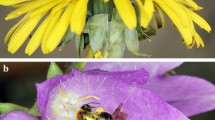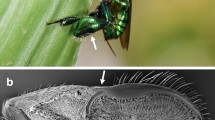Abstract
Male neotropical orchid bees (Euglossini) collect volatile chemicals from orchid flowers and other sources and store them in hind leg cavities. The accumulated fragrance bouquets are later emitted at mating sites. Although most other insects synthesize pheromone blends de novo, specific euglossine perfumes are derived from active choices in a changing fragrance market. Male bees of three species of Euglossa possessed distinctive fragrance phenotypes showing little variation by locality and habitat in mainland Central America. In cage experiments, fragrance choice by male Euglossa imperialis was influenced markedly by a bee's collection history. Collection of a given chemical strongly reduced its attractiveness on subsequent occasions, an effect that was retained over days. Experimentally adding the chemicals directly to bee hind legs produced no effect. We conclude that bees learn and remember chemicals they collect. Innate odor preferences, memory and the avoidance of overcollecting by negative feedback may be the primary mechanisms that ensure unique blends of pheromone analogs in these tropical forest bees.




Similar content being viewed by others
References
Ackerman JD (1983) Specificity and mutual dependency of the orchid-euglossine bee interaction. Biol J Linn Soc 20:301–314
Ackerman JD (1989) Geographic and seasonal variation in fragrance choice and preferences of male euglossine bees. Biotropica 21:340–347
Ackerman JD, Montalvo AM (1985) Longevity of euglossine bees. Biotropica 17:79–81
Adams RP (2001) Identification of essential oil components by Gas Chromatography/Quadrupole Mass Spectroscopy. Allured Publishing Corporation, Carol Stream, USA
Ayasse M, Paxton RJ, Tengo J (2001) Mating behavior and chemical communication in the order hymenoptera. Annu Rev Entomol 46:31–78
Bergman P, Bergstrom G (1997) Scent marking, scent origin, and species specificity in male premating behavior of two Scandinavian bumblebees. J Chem Ecol 23:1235–1251
Bjostad LB, Wolf WA, Roelofs WL (1987) Pheromone biosynthesis in Lepidopterans: desaturation and chain shortening. In: Prestwich GD, Blomquist GJ (eds) Pheromone biochemistry. Academic Press, Orlando, pp 77–119
Cameron SA (2004) Phylogeny and biology of neotropical orchid bees (Euglossini). Annu Rev Entomol 49:377–404
Cardé RT, Baker TC (1984) Sexual communication with pheromones. In: Bell WJ, Cardé RT (eds) Chemical ecology of insects. Chapman and Hall, London New York, pp 355–376
Carew TJ, Pinsker HM, Kandel ER (1972) Long-term habituation of a defensive withdrawal reflex in Aplysia. Science 175:451–454
Chandra S, Smith BH (1998) An analysis of synthetic processing of odor mixtures in the honeybee (Apis mellifera). J Exp Biol 201:3113–3121
Chandra SBC, Hosler JS, Smith BH (2000) Heritable variation for latent inhibition and its correlation with reversal learning in honeybees (Apis mellifera). J Comp Psychol 114:86–97
Clarke KR (1993) Nonparametric multivariate analyses of changes in community structure. Aust J Ecol 18:117–143
Clarke KR (1999) Nonmetric multivariate analysis in community-level ecotoxicology. Environ Toxicol Chem 18:118–127
Clarke KR, Gorley RN (2001) PRIMER v5: user manual/tutorial. Primer-E Ltd, Plymouth
Clarke KR, Green RH (1988) Statistical design and analysis for a ‘biological effects‘ study. Mar Ecol Progr Ser 46:213–226
Clarke KR, Warwick RM (2001) Change in marine communities: an approach to statistical analysis and interpretation, 2nd edn. PRIMER-E Ltd, Plymouth
Cromarty SI, Derby CD (1997) Multiple excitatory receptor types on individual olfactory neurons: implications for coding of mixtures in the spiny lobster. J Comp Physiol A 180:481–491
Dodson CH (1975) Coevolution of orchids and bees. In: Gilbert LC, Raven PH (eds) Coevolution of animals and plants. University of Texas Press, Austin, pp 91–99
Dodson CH, Dressler RL, Hills HG, Adams RM, Williams NH (1969) Biologically active compounds in orchid fragrances. Science 164:1243–1249
Dressler RL (1968) Pollination by euglossine bees. Evolution 22:202–210
Dressler RL (1982) Biology of the orchid bees (Euglossini). Ann Rev Ecol Syst 13:373–394
Eltz T, Roubik DW, Whitten WM (2003) Fragrances, male display and mating behaviour of Euglossa hemichlora—a flight cage experiment. Phys Entomol 28:251–260
Eltz T, Sager A, Lunau K (2005) Juggling with volatiles: exposure of perfumes by displaying male orchid bees. J Comp Physiol A, 191:575–581
Eltz T, Whitten WM, Roubik DW, Linsenmair KE (1999) Fragrance collection, storage, and accumulation by individual male orchid bees. J Chem Ecol 25:157–176
Engel MS (1999) The first fossil Euglossa and the phylogeny of the orchid bees (Hymenoptera: Apidae: Euglossini). Am Mus Novit 3272:1–14
Freeland WJ, Janzen DH (1974) Strategies in herbivory by mammals—role of plant secondary compounds. Am Nat 108:269–289
Gerlach G, Schill R (1989) Fragrance analyses, an aid to taxonomic relationships of the genus Coryanthes (Orchidaceae). Plant Syst Evol 168:159–165
Gerlach G, Schill R (1991) Composition of orchid scents attracting euglossine bees. Bot Acta 104:379–391
Hosler JS, Smith BH (2000) Blocking and the detection of odor components in blends. J Exp Biol 203:2797–2806
Janzen DH (1971) Euglossine bees as long-distance pollinators of tropical plants. Science 171:203–205
Janzen DH (1981) Reduction in euglossine bee species richness on Isla del Cano, a Costa Rican offshore island. Biotropica 13:238–240
Janzen DH, DeVries PJ, Higgins ML, Kimsey LS (1982) Seasonal and site variation in Costa Rican euglossine bees at chemical baits in lowland decidous and evergreen forest. Ecology 63:66–74
Kaiser R (1993) The scent of orchids—olfactory and chemical investigations. Hoffmann La Roche, Basel
Kimsey LS (1980) The behaviour of male orchid bees (Apidae, Hymenoptera, Insecta) and the question of leks. Anim Behav 28:996–1004
Krehbiel MD, Nagel PJ (1998) A comparison of euglossine species diversity between Isla del Cano, a Costa Rican offshore island, and the adjacent mainland. Online publication http://www.educationabroad.com/body_alumni_projects_ spring97_5.htm
Legendre P, Legendre L (1998) Numerical ecology, 2nd edn. Elsevier, Amsterdam
Linn CE, Roelofs WL (1995) Pheromone communication in moths and its role in the speciation process. In: Lambert DM, Spencer HG (eds) Speciation and the recognition concept. The Johns Hopkins University Press, Baltimore, pp 263–300
Minckley RL, Buchmann SL, Wcislo WT (1991) Bioassay evidence for a sex attractant pheromone in the large carpenter bee, Xylocopa varipuncta (Anthophoridae, Hymenoptera). J Zool 224:285–291
Morse D, Meighen E (1987) Pheromone biosynthesis: enzymatic studies in Lepidoptera. In: Prestwich GD, Blomquist GJ (eds) Pheromone biochemistry. Academic Press, Orlando, pp 121–158
Murren CJ (2002) Effects of habitat fragmentation on pollination: pollinators, pollinia viability and reproductive success. J Ecol 90:100–107
Pearson DL, Dressler RL (1985) Two-year study of male orchid bee (Hymenoptera: Apidae: Euglossini) attraction to chemical baits in lowland south-eastern Peru. J Trop Ecol 1:37–54
Provenza FD (1996) Acquired aversions as the basis for varied diets of ruminants foraging on rangelands. J Anim Sci 74:2010–2020
Ramirez S, Dressler RL, Ospina M (2002) Abejas euglosinas (Hymenoptera: Apidae) de la Región Neotropical: Listado de especies con notas sobre su biología. Biota Colombiana 3:7–118
Roelofs WL (1995) The chemistry of sex sex attraction. In: Eisner T, Meinwald J (eds) Chemical Ecology. National Academy Press, Washington, DC, pp 103–118
Roelofs WL, Liu WT, Hao GX, Jiao HM, Rooney AP, Linn CE (2002) Evolution of moth sex pheromones via ancestral genes. Proc Natl Acad Sci USA 99:13621–13626
Roelofs WL, Rooney AP (2003) Molecular genetics and evolution of pheromone biosynthesis in Lepidoptera. Proc Natl Acad Sci USA 100:9179–9184
Roubik DW, Hanson PE (2004) Orchid bees of tropical America: Biology and field guide. Instituto Nacional de Biodiversidad (INBio), Heredia, Costa Rica
Smith BH, Getz WM (1994) Nonpheromonal olfactory processing in insects. Annu Rev Entomol 39:351–375
Stern DL (1991) Male territoriality and alternative male behaviors in the euglossine bee, Eulaema meriana (Hymenoptera: Apidae). J Kansas Entomol Soc 64:421–437
Stopfer M, Chen XH, Tai YT, Huang GS, Carew TJ (1996) Site specificity of short-term and long-term habituation in the tail-elicited siphon withdrawal reflex of Aplysia. J Neurosci 16:4923–4932
Vogel S (1966) Parfümsammelnde Bienen als Bestäuber von Orchidaceen und Gloxinia. Österr Botan Zeit 113:302–361
Wasserman EA, Miller RR (1997) What's elementary about associative learning? Annu Rev Psychol 48:573–607
White CS, Lambert DM, Foster SP (1995) Chemical signals and the recognition concept. In: Lambert DM, Spencer HG (eds) Speciation and the recognition concept. The Johns Hopkins University Press, Baltimore, pp 301–326
Whitten WM, Williams NH (1992) Floral fragrances of Stanhopea (Orchidaceae). Lindleyana 7:130–153
Whitten WM, Williams NH, Armbruster WS, Battiste MA, Strekowski L, Lindquist N (1986) Carvone oxide: an example of convergent evolution in euglossine pollinated plants. Syst Bot 11:222–228
Whitten WM, Young AM, Stern DL (1993) Nonfloral sources of chemicals that attract male euglossine bees (Apidae: Euglossini). J Chem Ecol 19:3017–3027
Whitten WM, Young AM, Williams NH (1989) Function of glandular secretions in fragrance collection by male euglossine bees. J Chem Ecol 15:1285–1295
Williams NH (1982) The biology of orchids and euglossine bees. In: Arditti J (ed) Orchid biology: reviews and perspectives. Cornell University Press, Ithaca, NY, pp 119–171
Williams NH, Dodson CH (1972) Selective attraction of male euglossine bees to orchid floral fragrances and its importance in long distance pollen flow. Evolution 26:84–95
Williams NH, Whitten WM (1983) Orchid floral fragrances and male euglossine bees: methods and advances in the last sesquidecade. Biol Bull 164:355–395
Acknowledgements
Work and manuscript benefited substantially from discussions held within the Sensory Ecology Group seminar in Düsseldorf. Randolf Menzel, Bertram Gerber, and an anonymous reviewer provided insights concerning learning mechanisms. The chemical–analytical part of the study was substantiated by Roman Kaiser, who cross-checked reference samples and identified critical fragrance compounds. Günter Gerlach provided chemical baits and access to his wealth of baiting data. Georg Pohland and Peter Mullen helped to collect bee samples in Costa Rica and Panama. The study was sponsored by DFG grant EL 249/2-1
Author information
Authors and Affiliations
Corresponding author
Additional information
Communicated by R.F.A. Moritz
An erratum to this article can be found at http://dx.doi.org/10.1007/s00265-005-0093-9
Electronic supplementary material
S1
Incidence, average relative abundance, and contribution to within-species similarity of fragrance components in hind-leg extracts of three species of Euglossa in mainland Panama (pooled across localities 2, 3, and 4).
S2
Incidence, average relative abundance, and contribution to within-species similarity of fragrance components in hind-leg extracts of Euglossa tridentata at six localities in Panama and Costa Rica.
Rights and permissions
About this article
Cite this article
Eltz, T., Roubik, D.W. & Lunau, K. Experience-dependent choices ensure species-specific fragrance accumulation in male orchid bees. Behav Ecol Sociobiol 59, 149–156 (2005). https://doi.org/10.1007/s00265-005-0021-z
Received:
Revised:
Accepted:
Published:
Issue Date:
DOI: https://doi.org/10.1007/s00265-005-0021-z




